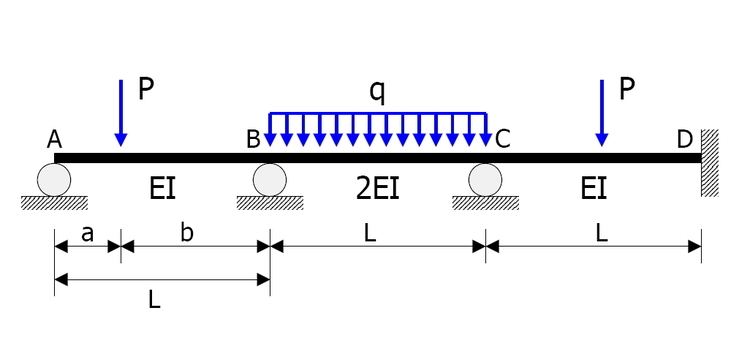 | ||
The moment distribution method is a structural analysis method for statically indeterminate beams and frames developed by Hardy Cross. It was published in 1930 in an ASCE journal. The method only accounts for flexural effects and ignores axial and shear effects. From the 1930s until computers began to be widely used in the design and analysis of structures, the moment distribution method was the most widely practiced method.
Contents
Introduction
In the moment distribution method, every joint of the structure to be analysed is fixed so as to develop the fixed-end moments. Then each fixed joint is sequentially released and the fixed-end moments (which by the time of release are not in equilibrium) are distributed to adjacent members until equilibrium is achieved. The moment distribution method in mathematical terms can be demonstrated as the process of solving a set of simultaneous equations by means of iteration.
The moment distribution method falls into the category of displacement method of structural analysis.
Implementation
In order to apply the moment distribution method to analyse a structure, the following things must be considered.
Fixed end moments
Fixed end moments are the moments produced at member ends by external loads when the joints are fixed.
Flexural stiffness
The flexural stiffness (EI/L) of a member is represented as the product of the modulus of elasticity (E) and the second moment of area (I) divided by the length (L) of the member. What is needed in the moment distribution method is not the exact value but the ratio of flexural stiffness of all members.
Distribution factors
When a joint is released and begins to rotate under the unbalanced moment, resisting forces develop at each member framed together at the joint. Although the total resistance is equal to the unbalanced moment, the magnitudes of resisting forces developed at each member differ by the members' flexural stiffness. Distribution factors can be defined as the proportions of the unbalanced moments carried by each of the members. In mathematical terms, distribution factor of member
where n is the number of members framed at the joint.
Carryover factors
When a joint is released, balancing moment occurs to counterbalance the unbalanced moment which is initially the same as the fixed-end moment. This balancing moment is then carried over to the member's other end. The ratio of the carried-over moment at the other end to the fixed-end moment of the initial end is the carryover factor.
Determination of carryover factors
Let one end (end A) of a fixed beam be released and applied a moment
In case of a beam of length L with constant cross-section whose flexural rigidity is
therefore the carryover factor
Sign convention
Once a sign convention has been chosen, it has to be maintained for the whole structure. The traditional engineer's sign convention is not used in the calculations of the moment distribution method although the results can be expressed in the conventional way. In the BMD case, the left side moment is clockwise direction and other is anticlockwise direction so the bending is positive and is called sagging.
Framed structures
Framed structures with or without sidesway can be analysed using the moment distribution method.
Example
The statically indeterminate beam shown in the figure is to be analysed.
In the following calculations, counterclockwise moments are positive.
Fixed end moments
Flexural stiffness and distribution factors
The flexural stiffness of members AB, BC and CD are
The distribution factors of joints A and D are
Carryover factors
The carryover factors are
Moment distribution
Numbers in grey are balanced moments; arrows ( → / ← ) represent the carry-over of moment from one end to the other end of a member.* Step 1: As joint A is released, balancing moment of magnitude equal to the fixed end moment
Result
For comparison purposes, the following are the results generated using a matrix method. Note that in the analysis above, the iterative process was carried to >0.01 precision. The fact that the matrix analysis results and the moment distribution analysis results match to 0.001 precision is mere coincidence.
Note that the moment distribution method only determines the moments at the joints. Developing complete bending moment diagrams require additional calculations using the determined joint moments and internal section equilibrium.
Result via displacements method
As the Hardy Cross method provides only approximate results, with a margin of error inversely proportionate to the number of iterations, it is important to have an idea of how accurate this method might be. With this in mind, here is the result obtained by using an exact method: the displacement method
For this, the displacements method equation assumes the following form:
For the structure described in this example, the stiffness matrix is as follows:
The equivalent nodal force vector:
Replacing the values presented above in the equation and solving it for
Hence, the moments evaluated in node B are as follows:
The moments evaluated in node C are as follows:
